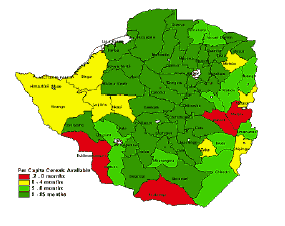|
Back to Index
FEWS
Zimbabwe Food Security Emergency 6 Aug 2004 - Food access remains
a concern
Famine
Early Warning System Network (FEWSNET)
August 06, 2004
View
this document on www.reliefweb.int
Access to
Food Continues to be the Biggest Food Security Challenge in 2004/05
Consumption Year
Zimbabwe continues
to face a severe food security crisis characterized by high levels
of unemployment and inflation, foreign exchange constraints, poor
agricultural production over the last four years, drought, and poor
government policies, exacerbated by crippling levels of HIV/AIDS.
In September last year, the Zimbabwe Vulnerability Assessment Committee
(ZimVAC) estimated 2.5 million people in the urban areas to be food
insecure. Although some food security indicators have improved in
recent months, many Zimbabweans continue to face conditions of extreme
food insecurity. Rural food security and vulnerability assessment
conducted by the ZimVAC in April 2004 estimated that at the peak
of the hunger period (December to March) about 2.3 million rural
people will be in need of food assistance.
The controversy
surrounding Zimbabwe's cereal production for the 2003/04 agricultural
season - coupled with the lack of data on cereal imports - continues
to make thorough food security analysis and response planning very
difficult. However, sub national data indicate that cereals are
still generally available in most rural districts from own and local
production, but is becoming scarce in Buhera, Mutare, Bietbridge
and Bulilimangwe Districts, which are estimated to have produced
less than four months of their annual needs in the 2003/04 agricultural
season. An additional eight rural districts are expected to use
up their cereal harvests within the next four months (see map).
Food security is seriously threatened by cereal shortages in these
districts.
The suspension
of general feeding in April, May and June this year by food aid
agencies in the country in response to Government's announcement
that the country has enough food from the 2003/04 agricultural season's
harvest has left the majority of food insecure households more dependent
on their limited consumption, expenditure and income coping strategies.
The ZimVAC estimated that about 2.2 million people in the rural
areas will not be able to meet all their food needs on their own
between July and November 2004 and during this period they would
require food assistance, which is about 52,000 MT. The number of
rural people expected to require food assistance during the hunger
period (December 2004 to March 2005) is expected to peak at 2.3
million.
Average Cereals
Available (months) to Rural District Population from the Estimated
2003/2004 Production as of 31 July 2004

Source: FEWS
NET/USGS
The availability
of basic food stuffs is stable in most markets in the urban areas,
but low households' purchasing power has remained a major food security
problem; this has been further compounded by high unemployment levels
and high inflation rates. Minimum wage reviews done in April 2004
have seen minimum wages of industrial workers going up by more than
190 percent, from Z$114,594 to Z$341,655. However, the new wage
rate is just enough to cover 30 percent of the cost of the total
CCZ low income household basket for June 2004 estimated at Z$1,143,510.
The situation has marginally worsened compared to last May.
Water cuts lasting
for weeks and frequent sewage blockages that go for days without
being attended to are becoming more of a norm than an exception
in Harare and other smaller towns. These water problems are coupled
with irregular collection of refuse and uncontrolled vegetable vendors
putting up shop everywhere, and are posing a serious health hazard
to Zimbabwe's urban population.
Recommended
Actions
- Sub-district
level assessments are urgently required to identify the food insecure
and appropriate food assistance rendered to them to avoid dire
consequences.
- NGOs and
Government should embark on livelihoods recovery programs based
on soon to be published livelihoods assessments such as the Zimbabwe
VAC assessments and the Poverty Assessment Study.
- With food
access of great continuing concern, targeted food aid should continue
throughout the country for poor socio-economic groups. Improved
maize availability will not address the famine threat that could
occur in some parts of the country this year. Special attention
is required for the most vulnerable households in Manicaland and
Matebeleland South Provinces.
- Improved
management of municipalities and urban boards should address most
of these problems, for they are by and large results of mismanagement.
Central Government budgeting should make provisions for water
and sewage infrastructure renovations and development.
Visit
the FEWSNET website
Please credit www.kubatana.net if you make use of material from this website.
This work is licensed under a Creative Commons License unless stated otherwise.
TOP
|

